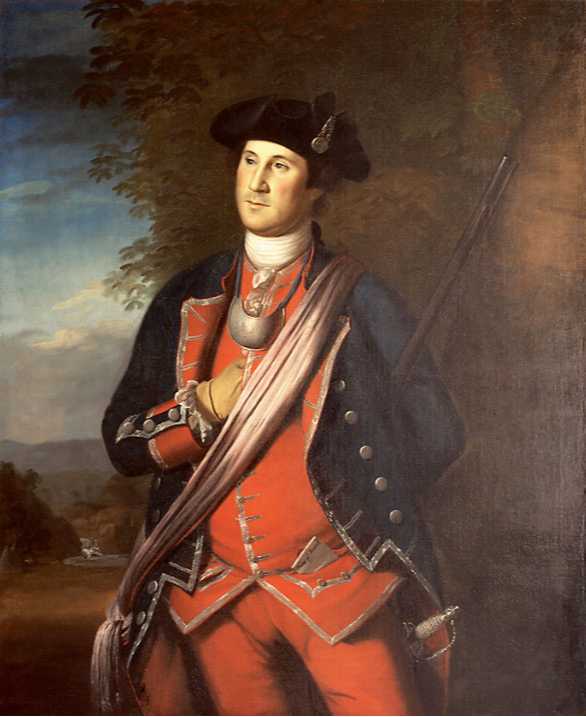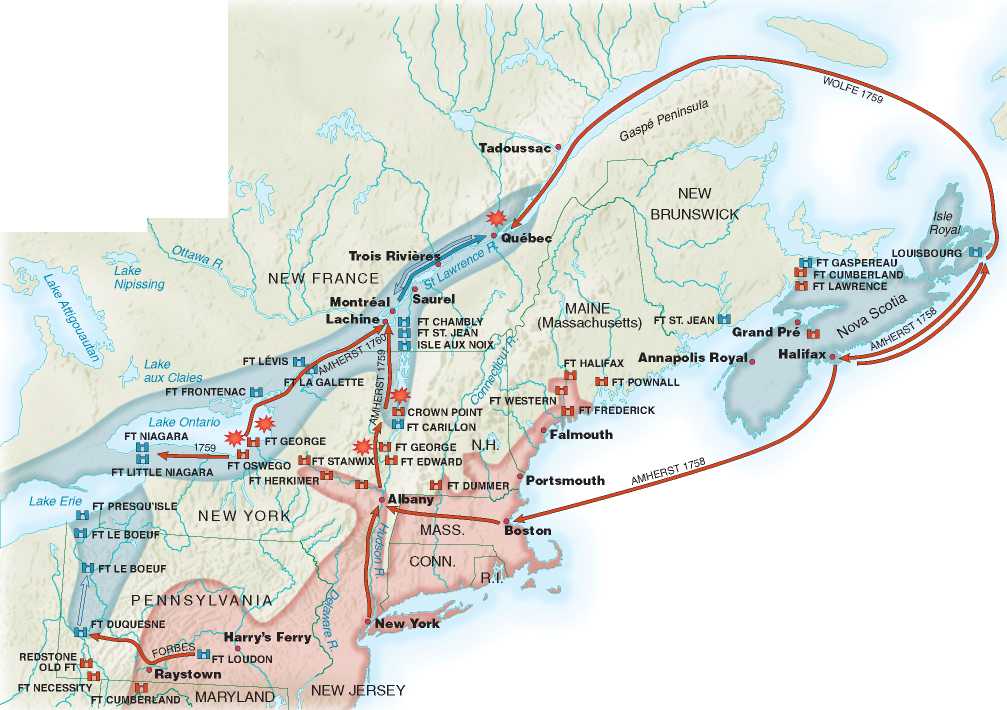¦ The English parents of the girl in this story insisted that she was truly a colonist; her adoptive parents declared that she had become an Indian. What do you think defines a person's identity? Can a person renounce an identity or heritage?
¦ When immigrants and slaves arrived in what is now the United States, which aspects of their European or African heritage did they cling to, and which did they repudiate? Did their sense of self fundamentally change?

This is the first portrait of George Washington, painted by John Gadsby Chapman. Washington's right hand is inside his vest, a convention later associated with Napoleon; his left hand is behind his back. Perhaps this was to spare the painter of the trouble of rendering hands and fingers, which were always a challenge.
With trifling exceptions, an insulating band of wilderness had always separated the French and English in America. Now the two powers came into contact. The immediate result was a showdown battle for control of North America, the “great war for the empire.” Thoroughly alarmed by the presence of the English on land they had long considered their own, the French struck hard. Attacking suddenly in 1752, they wiped out Croghan’s post at Pickawillany and drove his traders back into Pennsylvania. Then they built a string of barrier forts south from Lake Erie along the Pennsylvania line: Fort Presque Isle, Fort Le Boeuf, and Fort Venango.
The Pennsylvania authorities chose to ignore this action, but Lieutenant Governor Robert Dinwiddie of Virginia (who was an investor in the Ohio Company) dispatched a twenty-one-year-old surveyor named George Washington to warn the French that they were trespassing on Virginia territory.
Washington, a gangling, inarticulate, and intensely ambitious young planter, made his way northwest in the fall of 1753 and delivered Dinwiddie’s message to the commandant at Fort Le Boeuf. It made no impression. “[The French] told me,” Washington reported, “that it was their absolute Design to take Possession of the Ohio, and by G— they would do it.” Governor Dinwiddie thereupon promoted Washington to lieutenant colonel and sent him back in the spring of 1754 with 150 men to seize a strategic junction south of the new French forts, where the Allegheny and Monongahela rivers join to form the Ohio.
Eager but inexperienced in battle, young Washington botched his assignment. As his force labored painfully through the tangled mountain country southeast of the fork of the Ohio, he received word that the French had already occupied the position and were constructing a powerful post, Fort Duquesne. Outnumbered by perhaps four to one, Washington foolishly pushed on. He surprised and routed a French reconnaissance party, and then blundered into the main body of enemy troops.
Hastily he threw up a defensive position, aptly named Fort Necessity, but the ground was ill chosen; the French easily surrounded the fort and Washington had to surrender. After tricking the young officer, who could not read French, into signing an admission that he had “assassinated” the leader of the reconnaissance party, his captors, with the gateway to the Ohio country firmly in their hands, permitted him and his men to march off. Nevertheless, Washington returned to Virginia a hero, for although still undeclared, this was war, and he had struck the first blow against the hated French.
In the resulting conflict, which historians call the French and Indian War (to the colonists it was simply “the French War”), the English outnumbered the French by about 1.5 million to 90,000. But the English were divided and disorganized, while the French were disciplined and united. The French controlled the disputed territory, and most of the Indians took their side. As a colonial official wrote, together they made formidable forest fighters, “sometimes in our Front, sometimes in our Rear, and often on all sides of us,
Table 3.1 English Wars,1689-1763
War | Date | Purpose in North America | Outcome |
King William's War | 1689-1697 | Control of New England and New York frontier, St. Lawrence Valley | No change |
Queen Anne's War | 1702-1713 | Control of northern frontier, also much of Canada | France surrenders Nova Scotia, Newfoundland, and Hudson Bay to Great Britain |
King George's War | 1744-1748 | Control of St. Lawrence River and its Approaches | Louisbourg fortress captured by British but returned to France by treaty |
Great War for the Empire | 1754-1763 | Control of New France | France cedes nearly all of New France to Great Britain |
Hussar Fashion, taking the Advantage of every Tree and Bush.” With an ignorance and arrogance typical of eighteenth-century colonial administration, the British mismanaged the war and failed to make effective use of local resources. For several years they stumbled from one defeat to another.
General Edward Braddock, a competent but uninspired soldier, was dispatched to Virginia to take command. In June 1755 he marched against Fort Duquesne with 1,400 Redcoats and a smaller number of colonials, only to be decisively defeated by a much smaller force of French and Indians. Braddock died bravely in battle, and only 500 of his men, led by Colonel Washington, who was serving as his aide-decamp, made their way back to Virginia.
Elsewhere Anglo-American arms fared little better in the early years of the war. Expeditions against Fort Niagara, key to all French defenses in the West, and Crown Point, gateway to Montreal, bogged down. Meanwhile Indians, armed by the French, bathed the frontier in blood. Venting the frustration caused by 150 years of white advance, they attacked defenseless outposts with unrestrained brutality.
The most feared of the “French” Indians were the Delaware, a once-peaceful Pennsylvania tribe that had been harried from their homelands by English and Iroquois. General Braddock paid his Indian allies only ?5 each for French scalps but offered ?200 for the hair of Shinngass, the Delaware chieftain.
In 1756 the conflict spread to Europe to become the Seven Years’ War. Prussia sided with Great Britain, and Austria with the French. On the world stage, too, things went badly for the British. Finally, in 1758, as defeat succeeded defeat, King George II was forced to allow William Pitt, whom he detested, to take over leadership of the war effort.
Pitt, grandson of “Diamond” Pitt, a nouveau riche East India merchant, was an unstable man who spent much of his life on the verge of madness, but he was a brilliant strategist and capable of inspiring the nation in its hour of trial.
Pitt recognized, as few contemporaries did, the potential value of North America. Instead of relying on the tightfisted and shortsighted colonial assemblies for men and money, he poured regiment after regiment of British regulars and the full resources of the British treasury into the contest, mortgaging the future recklessly to ensure victory over the French. Grasping the importance of sea power in fighting a war on the other side of the Atlantic, he used the British navy to bottle up the enemy fleet and hamper French communications with Canada. He possessed a keen eye for military genius, and when he discovered it, he ignored seniority and the outraged feelings of mediocre generals and promoted talented young officers to top commands. (His greatest find was James Wolfe, whom he made a brigadier at age thirty-one.)
In the winter of 1758, as Pitt’s grand strategy matured, Fort Duquesne fell. It was appropriately renamed Fort Pitt, the present Pittsburgh. The following summer Fort Niagara was overrun. General Jeffrey Amherst took Crown Point, and Wolfe sailed up the St. Lawrence to Quebec. There General Louis Joseph de Montcalm had prepared formidable defenses, but after months of probing and planning, Wolfe found and exploited a chink in the city’s armor and captured it. Both he and Montcalm died in the battle. In 1760 Montreal fell and the French abandoned all Canada to the British. The British also won major victories against Spanish forces in Cuba and Manila, and against the French in the West Indies and India.
C'J>lSee the Map The Seven Years' War at myhistorylab. com

ATLANTIC OCEAN
British Successes, 1758-1763 In 1758, in western Pennsylvania, British General John Forbes seized Ft. Duquesne and renamed it Ft. Pitt, in honor of William Pitt, who had orchestrated the military campaign in London. (In 1909 Forbes was posthumously honored when the Pittsburgh Pirates named their new stadium after him.) In 1759 a multipronged British expedition seized northern and western New York while another British army, commanded by James Wolfe, sailed down the St. Lawrence and captured Montreal in 1760.




 World History
World History









